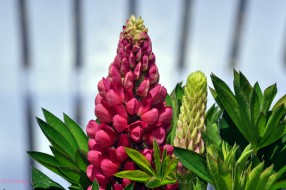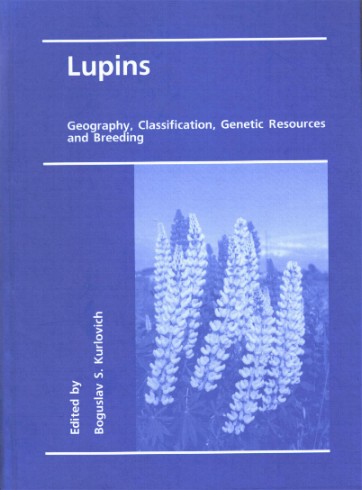LUPINS - OUR PUBLICATION

Theoretically, our research is founded on the works of Prof. N.I.Vavilov. Nikolai I. Vavilov is recognized as the foremost plant geographer, botanist and geneticist of this age. In the early 20thcentury, the world was yet unaware of the urgent necessity to protect the environments, and scientists thought little about gradual extinction of plant species. In fact, N.I. Vavilov was the first who understood the imperative of intensive plant collecting, studying and preservation, in spite of the hardest times he experienced in his life. In order to explore the major agricultural regions over the world, Vavilov organized and took part in over 100 collecting missions. During these expeditions, he always focused special attention on leguminous crops in general, and to lupin in particular, regarding it as a source of protein and means of increasing of soils fertility (Sinskaja,1991). He considered this problem as the highest priority in biological and agricultural science and in the attempts to develop sustainable agricultural production. As a result of these efforts, by 1940 about 200 thousand accessions had been stored in Vavilov’s collection. Such a rich diversity was thoroughly analyzed in various eco-geographic conditions, systematized and preserved. Vavilov’s foresight concerning possibility of quick disappearance of many valuable plant forms under the influence of human activity proved prophetic. Only for the last 20 years, dozens of plant species and forms have vanished from earth, but many species and forms were saved thanks to the collecting efforts of Vavilov and his followers. Vavilov's activity in the field of collecting, studying and preservations of genetic resources of leguminous plants including lupin, is stated in the following work:
We also participated in many plant collecting missions, explored different regions of former USSR (Siberia, Far East, Kazakhstan, Caucasus, Middle Asia, Ukraine) and many others countries (Brazil, Peru, Argentina, Ecuador, Algeria, Portugal, Germany, Poland, Finland) and has collected a wide diversity of leguminous plants and their wild relatives, which are effectively used in Plant breeding in Finland, Poland and in many other countries. We represent here results of our researches of genetic resources in Portugal and on the island Madeira: Collecting plant genetic resources in Portugal
During 1984-91, we collected accessions of the Georgian ecotype of white lupin in Abkhazia (in the regions of Sukhumi, Ochamchira, Galy) and in Georgia (Zoogdidy, Poti, Lanchhutty, Maharadze, Samtredia, Kutaisi, Tshaltubo regions). Visits were made to farmers, collective farms, local scientific agricultural stations, regional administrators and markets, always in the summer, when the seeds were ripe. Collected materials testify to the breeding value of Western Georgian accessions of 'hanchcoly' as promising initial material for creation of new spring and winter varieties of L. albus for grain production, silage utilization and for green manure (Golovchenko et al. 1984; Kurlovich 1991; Kurlovich et al. 1995). Georgian ecotype of white lupine (Lupinus albus L.)
On the centers of species formation of the genus Lupinus L. ( in Russian )
О центрах формообразования видов рода Lupinus L.
(Research Bull. of the Vavilov Institute, Fasc.193, 1989, pp.20-24)
The paper presents the hypothesis on the occurrence of a single primary center of formation of the Genus LUPINUS in Laurasia in the Chalk period. As a result of the separation of the continents of about 50 min. years ago the main part of the territory attached to the North America, and the second, smaller part, to the Europe. Thus, two secondary centers of formation of different lupine species arose, one in the Mediterranean and the other on the American continent.
In view of the concept noted above it follows that the Genus Lupinus L. consists of two subgenera: subgen. Lupinus and subgen. Platycarpos (Wats.) Kurl., comb. nova.
We were guided in our research by Vavilov’s differential systematic and geographic method of analyzing cultivated plants, and his doctrine about species as a system. Previously the prevailing ideas were based on monotypic species, according to which species cannot include a systematic unit of a lower rank. Vavilov, however, in a study of several hundred species showed the absence of monotypic species, i.e. species represented by various forms. He considered species as «a flexible, isolated, complex, morph physiological system linked to a particular environment and area» Different intra-specific taksa (subspecies, varieties, subvarieties and forms) were classified within different species of Lupins on the basis of Vavilov’s concepts of species as a system. Our approaches to systematization and classifications of several species of lupin are stated in the following publications:
Intraspecific Diversity of Lupins
Species and intraspecific diversity of white,blue and yellow lupins
INТRASPECIFIC DIVERSIТY OF THREE ANNUAL LUPINE SPECIES (LUPINUS L.)
Standard IPNI abbreviation: Kurl.
Ecogeographic classification reflects the regularities of variability of these properties, which are based on the specific nature of geographic, historical, ecological and agronomic conditions. It cannot replace the botanical classification of the species, which requires clear difference of morphological characters as observed on the herbarium materials, but supplements it. Taken together they provide for purposeful and conscious utilization of plant genetic diversity in breeding practice, as N.I. Vavilov repeatedly marked. Below the following article is published in: Advances in Lupin Research (J.M. Martins and M.L.Beirao da Costa, eds.). Proceedings of the 7th International Lupin Conference, Evora, Portugal. ISA Press, Lisbon, 1994. ECOGEOGRAPHIC CLASSIFICATION OF LUPINUS ALBUS, L. ANGUSTIFOLIUS AND L. LUTEUS.
High efficiency of testing accessions of lupin in different ecological and geographical conditions on the united strategy is installed . Our research has shown that phenotypic manifestation of determinacy of branching includes influence of genotype, influence of environment, as well as genotype - environment interaction. Eco-geographical studies have allowed to reveal the genotype with the high stability of character of determinate branching in different conditions ( accession Ladny). This accession is broadly used in breeding process in many countries (Belarus, Germany, Latvia, Lithuania, Poland, Russia, and Ukraine) as the source of early-maturity, thermos and photo stability and neutrality. Eco-geographical investigations make it possible to create valuable material also through hybridization of forms with a different variability of characters, what often proves about nonallelity of controlled genes. This phenomenon allows as to obtain transgressive forms, the expressiveness of valuable characters at which one was better than at initial forms.
GENETIC AND ENVIRONMENTAL INFLUENCES ON BRANCHING IN NARROW-LEAFED LUPIN ( LUPINUS ANGUSTIFOLIUS L.)
Leguminous crops, including lupin, are an important source of protein and other nutritious substances. The major physiological and biochemical feature of lupin is the capability to synthesize plenty of protein. Due to its coexistence with nodule bacteria Bradyrhizobium sp. (Lupinus), lupin possesses high nitrogen-fixing ability, the means of acquiring molecular nitrogen from the atmosphere, which is used to produce protein and other nitrogen substances. Among the rich specific diversity of lupin, there are species, varieties and forms, which accumulate large amounts of protein, oil and other useful substances (Kurlovich, 1998). At the same time, between separate species, varieties and forms there are differences not only in the quantitative content of useful substances, but also in their qualitative structure.We represent publications on the mentioned problems:
Diversity of lupin (Lupinus L.) based on biochemical composition
Evaluation of the biological nitrogen-fixing ability of lupin (Lupinus L.)

Fusarium wilt is the most harmful soil-borne disease of lupins in Russia and in the Ukraine. The aim of the studies was to find broad resistance to disease in collection accessions and to breed lupin forms resistant to Fusarium wilt for the future breeding program. Lupin cultivars and lines (547 accessions) from the genebank of the N.I. Vavilov All Russian Scientific Research Institute of Plant Industry, St. Petersburg, Russia, were tested for Fusariumresistance under different environmental conditions of three regions in Russia and in the Ukraine on plots with artificially infested soil. So, differences in the disease susceptibility of the same accessions were found in contrasting environments. Resistant forms from one region were crossed with accessions showing their resistance in two other regions to accumulate resistance genes in new genotypes. As a result of hybridization two transgressive forms were obtained in F4 of the crosses cv. Frost x cv. Apendrilon (L. angustifolius) and line G-413 x line 85 (L. luteus). Their resistance in all three regions appeared to be higher than that of their parental forms. These two lines were found suitable for the breeding programme of Fusarium resistant forms in Russia and in the Ukraine. Concrete materials on problems of Fusarium are stated in the following articles:
(in Engish)
and
INITIAL MATERIAL FOR BREEDING LUPINE FOR RESISTANCE TO FUSARIAL VlLT (in Russian )
Our results in the field of lupins breeding are published here:
Lupins as a potential crop in Finland
BREEDING OF NARROW-LEAFED LUPIN FOR NORTHERN EUROPEAN GROWING CONDITIONS
Our Power Point presentation on the topic: « BREEDING OF NARROW-LEAFED LUPIN FOR NORTHERN EUROPEAN GROWING CONDITIONS » is HERE!
POTENTIAL AND PROBLEMS OF LUPINUS POLY PHY LLUS LINDL. DOMESTICATION
Our presentation on the topic: «POTENTIAL AND PROBLEMS OF LUPINUS POLYPHYLLUS LINDL. DOMESTICATION » is HERE!
BREEDING OF PERENNIAL FODDER FORMS OF MULTIFOLIATE LUPIN (LUPINUS POLYPHYLLUS LINDL.)
Further we will refer to our generalizing materials.
The book: «The genebank and breeding of grain legumes (lupine, vetch, soya and bean)» from a series «TEORETICAL BASIS OF PLANT BREEDING», Volume 111, St.Petersburg, VIR, 1995 (in Russian ), deals with new material on the theory of breeding of the above crops, biodiversity, intraspecific classification, the data on genetical studies, initial materials for various trends of breeding etc.
Lupins: Geography, Classification, Genetic Resources and Breeding
Boguslav S. Kurlovich
Bogouslav Kourlovitch, 2002 - 468 p.

Contents:Theoretical basis of our researshes; The review of the Genus Lupinus L.; Classifcation of lupins; Eco-geographic classification of Lupins (L. albus L., L. angustifolius L. end L. luteus L.); Biological features; Anatomic structure; Biology of flowering, embryological and caryological peculiarities; Biochemical composition; Nitrogen fixation; Diseases and pests; Genetic of lupins; Lupin breeding; Production of seed; Agronomy and farming system.
Materials of this book are available also on the Website Lupins.
The generalized materials of our researches are presented also here.
These books are the result of long standing experimental research conducted by its authors and it is supplemented by up-to-date data from scientific publications.
LEGUMINOUS PLANTS - family Leguminosae (Fabaceae)
The review of the most outstanding species of 46 genera of the family Leguminosae (Fabaceae) is given. This third family on size includes of 23 535 species united in 917 genera according to the newest data. A large number of legume species are cultivated worldwide as ornamentals, used as living fences and firebreaks, as soil binders, green manures, fodder for livestock, forage for honey bees, food for humans, in agro forestry and reforestation (for nitrogen fixation), as pulp for paper production, fuel woods, timber, and as sources of chemicals (e.g., dyes, tannins), oils (industrial, food, aromatherapy), and medicines. Many of the more common ones are listed in full text.
Family Leguminosae (Fabaceae) can be divided into three subfamily: Caesalpinioideae, Papilionodeae or Faboideae and Mimosoideae. The major of species belonging to 11 genera in subfamily Caesalpinioideae are described: Caesalpinia; Bauhinia; Ceratonia; Cercis; Gleditsia; Gymnoclаdus; Parkinsonia; Delonix; Copaifera; Guibourtia; Tamarindus. The description of the major species belonging to 31 genera of subfamily Papilionodeae is given: Arachis; Dalbergia; Lupinus; Astragаlus; Cicer); Glycyrrhiza; Hedysarum; Lathyrus; Lens; Pisum; Vicia, including Vicia sativa and Vicia faba; Vavilovia; Melilotus; Medicago; Onobrychis; Oxytropis; Trifolium; Wisteria; Cajanus; Canavalia; Derris; Millettia; Glycine; Indigofera; Phaseolus; Vigna; Pachyrhizus; Pueraria; Lotus; Robinia; Sesbania. Subfamily Mimosoideae is presented by 4 genera in our review: Mimosa; Acacia; Calliandrа and Entada.
The description of plants is stated partially on the basis of our 40-year-old researches, according to Wikipedia and other sources of the Internet and generalization of the world literature.
Full text here:
https://yadi.sk/d/51a7Xw-NWi4Wi